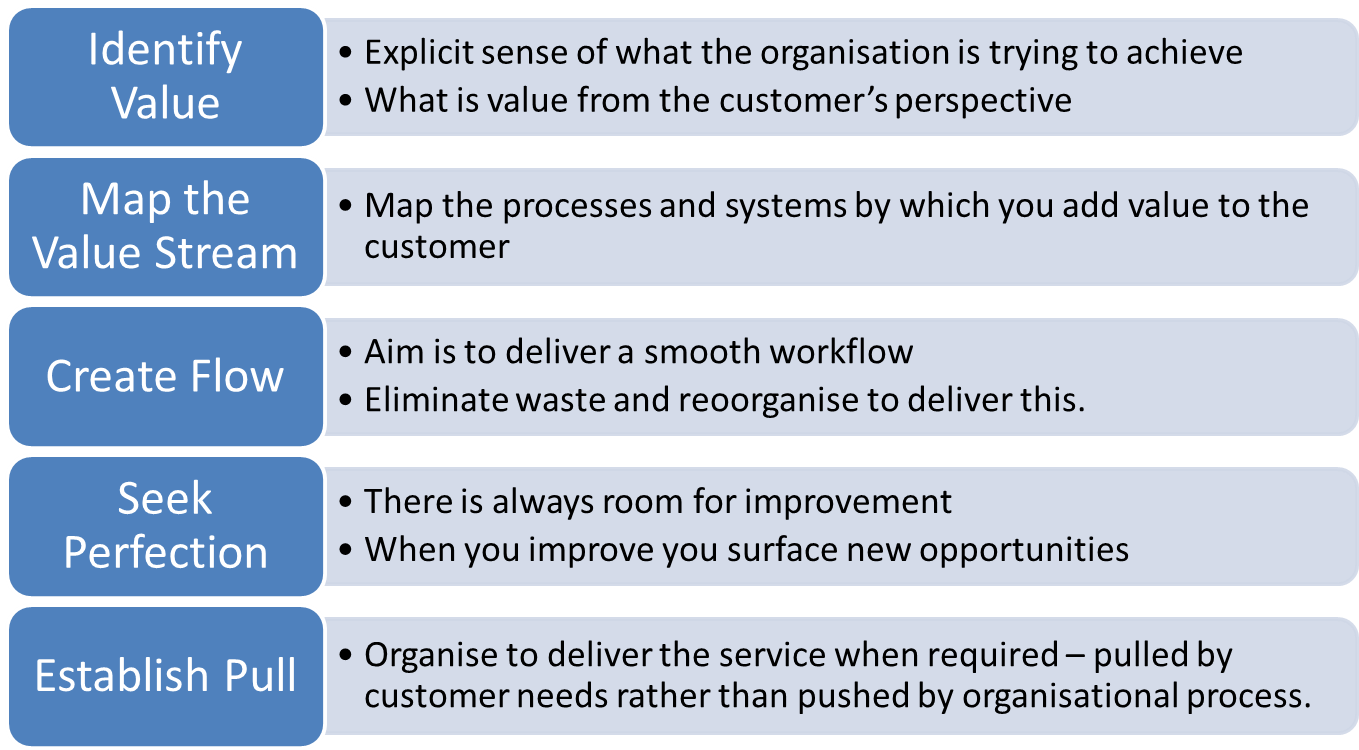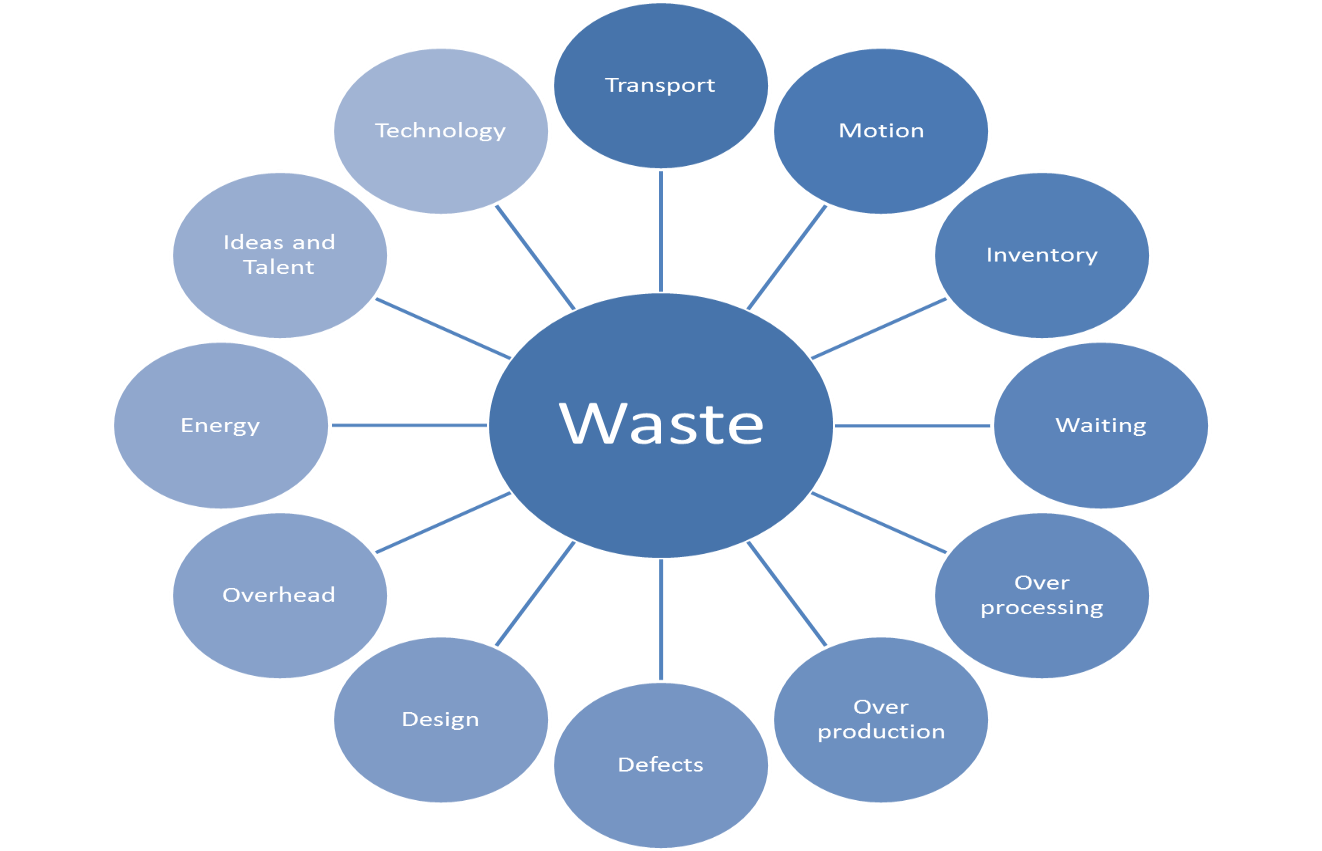Lean Management
Lean Management is about organisations ensuring they continually improve.
For the University this means continually exploring how we can better deliver research and teaching by analysing and improving processes and methods (academic and administrative) across the organisation.
It is about effectively using our resources (people, buildings, equipment) to deliver world-class outcomes for our customers in a way which does not put undue pressure on staff.
In Lean Management, a customer is the person who receives something of value from a series of processes. At the University this could be a colleague, a student, research funders, government, society.
Lean Management was originally adopted by manufacturing organisations but has spread to the service sector where it has had notable success in a wide range of organisations including health care and the Higher Education sector. Universities which have adopted Lean Management as an integral part of what they do include St Andrew’s and Aberdeen. Further information can be found on the Lean Higher Education hub.
The Two Pillars of Lean Management
Lean Management has two pillars:
- continuous improvement
- respect for people
Continuous improvement means being constantly engaged in looking at how we can better deliver teaching and research.
Respect for people means that people are at the heart of Lean Management by:
- recognising staff are experts in delivery of their role
- developing a culture that is open to being challenged
- developing a culture that is willing to innovate and change
- developing and encouraging challenge
- staff are actively involved in developing and designing changing in the own area
- empowering staff to make local decisions when possible
- supporting staff in improving in their role
The Five Principles of Lean

Identifying Value
What is important to the University and the individuals it serves: students, research funders, the academic community, government. For example, how important is it for students to have access to services such as the Library evenings and weekends?
Mapping the Processes (the ‘value stream’)
The value stream follows the steps the organisation takes to create value. Most processes will have steps that add real value and those which add little value and are wasteful and should be eliminated where possible. For example, applicants for Learning Works used to have to apply for a voucher before using their Learning Works funds with Services such as Sport. Human Resources found a way to eliminate this step which saved time and effort for applicants and staff.
Creating a Smooth Workflow
A Lean system flows from once process to the next smoothly and effectively to provide the desired value / outcome to the customer. For example a smooth student recruitment and enrolment workflow would mean there were no backlogs in the system, no long queues at registration and staff would be working at capacity but not beyond. Demand management and waste reduction both play a part.
Seek perfection
The Lean philosophy is that as you improved ‘there is always room to be better’ and that when you make changes, you open up opportunities for further improvement. For example staff involved in a lecture course where changes led to improved evaluations might ask:
- how could we make it even better? (what are the students saying)
- how could we achieve the same result with less effort or resources
- what might we learn for how we deliver this course to improve the way we deliver other courses
Deliver the Service When It Is Required
Lean organisations organise themselves in such a way that value / service is delivered when the customer wants it ‘demand pull’ rather than when the organisation wants to deliver it. For example extending Library opening hours due to student demand, providing online courses and resources (which can be accessed 24 / 7).
Waste Reduction
In Lean Management there are three types of waste:
- waste from unreasonable pressure on resources leading to a drop in quality and inconsistent standards of service (for example required staff have not been recruited and trained to deal with expected service demands such as student registration)
- waste resulting from ‘process variation’ (for example a poorly designed double marking scheme results in high variation of marks between markers and time spent dealing with this)
- waste identified when mapping the processes (value stream) and can be reduced; there are many types of this type of waste.
Examples of Value Stream Waste Reduction

Transport
Movement of people, objects, paper across the university or with organisations the University collaborates with. For example, are people travelling to meeting when a conference telephone call would do? Are items being distributed physically when electronic access would be sufficient?
Inventory / storage
Items which sit in storage for long periods of time without being used. For example, a chemical in a laboratory but is not being used takes space to store (that might be better used for something else) and might degrade and then never be used. Another example is the same electronic file being stored in several different places.
Waiting
This refers to the time people spend waiting for things to happen as this disrupts the flow of the process and can create bottlenecks and delays. For example, waiting for an IT system to respond or waiting for other people to deliver work to you in order to progress your own work
Over processing
Quality is about ‘fitness for purpose’ and the delivery of ‘excessive quality’ has the potential to create waste. For example, printing course notes in colour when black & white or an e-copy would be fine.
Overproduction
Producing more than necessary to complete a task or producing too far in advance of when needed. For example too much catering for a meeting or too many copies of course notes for the number of students.
Defects
Getting things wrong and then correcting usually takes more work that getting it right in the first place. Reducing defects usually helps you get better results with the same resources over the long term. For example, increasing the success rate of research grants by ensuring only those with a realistic chance of getting funded progress from initial outline into fully developed proposals.
Design
Good design of systems, processes and objects can lead to waste reduction. For example, in many universities the teaching spaces are designed with exactly the same IT set-up so staff find them easy to use and last-minute demands on AV staff are reduced.
Overhead
The effective use of space is a challenge. In general it is desirable that space is fully occupied vs rarely occupied as this saves un-necessary expenditure on space (e.g. heating and lighting). For example, ‘hot desking’ at Tay House means that a small number of work stations can be used by a large number of staff who spend a lot of time working off-site and do not need full time use of desk space.
Energy
Inefficient use of energy can lead to waste. Examples to trying to use energy more efficiently at the University can range from ensuring lights and computer monitors and switched off at the end of the day to large scale projects such as the District Heating Scheme.
Ideas and talent
Many organisations are not taking full advantage of their staff’s skills or ideas they might generate. For example, senior staff picking up job elements that could be more effectively done by other staff – such as senior academic staff photocopying large volumes of course notes or where ideas to improve systems and processes are not progressed because of a lack of appetite for change.
The Improvement Cycle
Teams which regularly use an improvement cycle to examine their activities get better at process improvement.

Plan
Establish what you want to achieve through the improvement process (e.g. reduce staff time spent on x so there is more time to do y) and develop a plan of how you will implement the desired changes.
Do
Implement the plan and collect information for the ‘check’ phased (e.g. how much time is spend on x)
Check
Look at the results and decide if they are what you expected; if not, consider where you are failing to get the expected results.
Act
If the process has improved you enact the new approach as your standard approach. If it has not improved, or the improvement is different than expected, then you go through the improvement cycle again.
Where to Put the Effort
A key Lean principle is knowing where to put effort into improvement activities. For example, it could be more effective to improve many small processes that take up a lot of staff time as they occur so often rather than focus on one large process that rarely occurs.
It can be helpful to categorise processes and activities as:
- frequent and part of core business (e.g. student registration, processing invoices); for these activities it may be worth investing in bespoke systems and processes to ensure they run as smoothly and efficiently as possible
- regular but not day-to-day activities (e.g. PhD student appealing a viva result, or a large procurement activity); processes should be well-developed but an investment in bespoke system may not provide the same gains as for more frequent activities
- very occasional activities where the development of bespoke process provide little benefit (for example unusual student welfare issues which are probably better managed on a case by case basis than by trying to develop improved processes and systems

